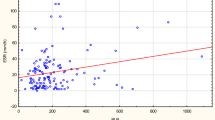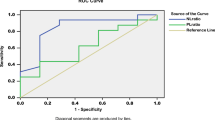Abstract
Bullous pemphigoid (BP) is a complex inflammatory process with elevated levels of autoantibodies, eosinophils, neutrophils, and various cytokines. Hematological inflammatory biomarkers can reflect inflammatory state in various diseases. Up to now, the correlations of hematological inflammatory biomarkers and disease activity of BP remain unknown. The purpose of this study was to clarify the associations between hematological inflammatory biomarkers and disease activity of BP. The levels of neutrophil-to-lymphocyte ratio (NLR), platelet-to-lymphocyte ratio (PLR), platelet-to-neutrophil ratio (PNR) and mean platelet volume (MPV) of 36 untreated BP patients and 45 age and gender matched healthy controls were detected by routine blood tests. The correlations between hematological inflammatory markers and clinical characteristics of BP were statistically analyzed. The Bullous Pemphigoid Disease Area Index (BPDAI) was used to measure disease activity of BP. The mean levels of NLR, PLR, PNR and MPV in 36 untreated BP patients were 3.9, 157.9, 45.7 and 9.4 fl, respectively. Increased NLR (p < 0.001), PLR (p < 0.01), and MPV (p < 0.001) but decreased PNR (p < 0.001) were observed in BP patients when compared with healthy controls. In BP patients, the levels of NLR were positively correlated to BPDAI Erosion/Blister Scores (p < 0.01); and the levels of NLR and PLR were both positively correlated to BPDAI without Damage Score (both p < 0.05) and BPDAI Total Score (both p < 0.05). No correlation was found in other statistical analyses between hematological inflammatory markers and clinical characteristics in BP patients involved in the present study. Therefore, NLR and PLR are positively correlated with disease activity of BP.
Similar content being viewed by others
Data availability
All data generated and analyzed during this study are included in the published article and any supplementary material.
References
Nishie W (2014) Update on the pathogenesis of bullous pemphigoid: an autoantibody-mediated blistering disease targeting collagen XVII. J Dermatol Sci 73(3):179–186
Kasperkiewicz M, Zillikens D (2007) The pathophysiology of bullous pemphigoid. Clin Rev Allergy Immunol 33(1–2):67–77
Goletz S, Zillikens D, Schmidt E (2017) Structural proteins of the dermal-epidermal junction targeted by autoantibodies in pemphigoid diseases. Exp Dermatol 26(12):1154–1162
Dopp R, Schmidt E, Chimanovitch I, Leverkus M, Brocker EB, Zillikens D (2000) IgG4 and IgE are the major immunoglobulins targeting the NC16A domain of BP180 in Bullous pemphigoid: serum levels of these immunoglobulins reflect disease activity. J Am Acad Dermatol 42(4):577–583
Daneshpazhooh M, Ghiasi M, Lajevardi V, Nasiri N, Balighi K, Teimourpour A et al (2018) BPDAI and ABSIS correlate with serum anti-BP180 NC16A IgG but not with anti-BP230 IgG in patients with bullous pemphigoid. Arch Dermatol Res 310(3):255–259
Ishiura N, Fujimoto M, Watanabe R, Nakashima H, Kuwano Y, Yazawa N et al (2008) Serum levels of IgE anti-BP180 and anti-BP230 autoantibodies in patients with bullous pemphigoid. J Dermatol Sci 49(2):153–161
Muhammed N, Korgaonkar S, Pradhan V, Khopkar US (2021) A Cross-sectional study to correlate disease severity in bullous pemphigoid patients with serum levels of autoantibodies against BP180 and BP230. Indian Dermatol Online J 12(5):696–700
Lee EH, Kim YH, Kim S, Kim SE, Kim SC (2012) Usefulness of enzyme-linked immunosorbent assay using recombinant BP180 and BP230 for serodiagnosis and monitoring disease activity of bullous pemphigoid. Ann Dermatol 24(1):45–55
Cai SC, Lim YL, Li W, Allen JC, Chua SH, Tan SH et al (2015) Anti-BP180 NC16A IgG titres as an indicator of disease activity and outcome in Asian patients with bullous pemphigoid. Ann Acad Med Singap 44(4):119–126
Tsuji-Abe Y, Akiyama M, Yamanaka Y, Kikuchi T, Sato-Matsumura KC, Shimizu H (2005) Correlation of clinical severity and ELISA indices for the NC16A domain of BP180 measured using BP180 ELISA kit in bullous pemphigoid. J Dermatol Sci 37(3):145–149
Feng S, Wu Q, Jin P, Lin L, Zhou W, Sang H et al (2008) Serum levels of autoantibodies to BP180 correlate with disease activity in patients with bullous pemphigoid. Int J Dermatol 47(3):225–228
Patsatsi A, Kyriakou A, Pavlitou-Tsiontsi A, Giannakou A, Sotiriadis D (2012) Association of autoantibodies to BP180 with disease activity in Greek patients with bullous pemphigoid. Clin Dev Immunol 2012:854795
Hashimoto T, Ohzono A, Teye K, Numata S, Hiroyasu S, Tsuruta D et al (2017) Detection of IgE autoantibodies to BP180 and BP230 and their relationship to clinical features in bullous pemphigoid. Br J Dermatol 177(1):141–151
van Beek N, Luttmann N, Huebner F, Recke A, Karl I, Schulze FS et al (2017) Correlation of serum levels of IgE autoantibodies against BP180 with bullous pemphigoid disease activity. JAMA Dermatol 153(1):30–38
Schmidt E, Obe K, Brocker EB, Zillikens D (2000) Serum levels of autoantibodies to BP180 correlate with disease activity in patients with bullous pemphigoid. Arch Dermatol 136(2):174–178
Amo Y, Ohkawa T, Tatsuta M, Hamada Y, Fujimura T, Katsuoka K et al (2001) Clinical significance of enzyme-linked immunosorbent assay for the detection of circulating anti-BP180 autoantibodies in patients with bullous pemphigoid. J Dermatol Sci 26(1):14–18
Marzano AV, Tedeschi A, Fanoni D, Bonanni E, Venegoni L, Berti E et al (2009) Activation of blood coagulation in bullous pemphigoid: role of eosinophils, and local and systemic implications. Br J Dermatol 160(2):266–272
Fang H, Shao S, Xue K, Yuan X, Qiao P, Zhang J et al (2021) Neutrophil extracellular traps contribute to immune dysregulation in bullous pemphigoid via inducing B-cell differentiation and antibody production. FASEB J 35(7):e21746
Park SH, Lee SH, Kim JH, Kim SC (2018) Circulating eosinophil and neutrophil counts correlate with disease severity in bullous pemphigoid. Ann Dermatol 30(5):544–549
de Graauw E, Sitaru C, Horn M, Borradori L, Yousefi S, Simon HU et al (2017) Evidence for a role of eosinophils in blister formation in bullous pemphigoid. Allergy 72(7):1105–1113
Liu Z, Giudice GJ, Zhou X, Swartz SJ, Troy JL, Fairley JA et al (1997) A major role for neutrophils in experimental bullous pemphigoid. J Clin Investig 100(5):1256–1263
Liu Z, Shapiro SD, Zhou X, Twining SS, Senior RM, Giudice GJ et al (2000) A critical role for neutrophil elastase in experimental bullous pemphigoid. J Clin Investig 105(1):113–123
Chiriac MT, Roesler J, Sindrilaru A, Scharffetter-Kochanek K, Zillikens D, Sitaru C (2007) NADPH oxidase is required for neutrophil-dependent autoantibody-induced tissue damage. J Pathol 212(1):56–65
Liu Z, Sui W, Zhao M, Li Z, Li N, Thresher R et al (2008) Subepidermal blistering induced by human autoantibodies to BP180 requires innate immune players in a humanized bullous pemphigoid mouse model. J Autoimmun 31(4):331–338
Briand C, Gourier G, Poizeau F, Jelti L, Bachelerie M, Quereux G et al (2020) Characteristics of pruritus in bullous pemphigoid and impact on quality of life: a prospective cohort study. Acta Derm Venereol 100(18):adv00320
Lyakhovitsky A, Dascalu J, Drousiotis T, Barzilai A, Baum S (2021) Hematological inflammatory markers in patients with pemphigus vulgaris. Dermatology 237(6):912–920
Akturk S, Buyukavci R (2017) Evaluation of blood neutrophil-lymphocyte ratio and platelet distribution width as inflammatory markers in patients with fibromyalgia. Clin Rheumatol 36(8):1885–1889
Gasparyan AY, Ayvazyan L, Mukanova U, Yessirkepov M, Kitas GD (2019) The platelet-to-lymphocyte ratio as an inflammatory marker in rheumatic diseases. Ann Lab Med 39(4):345–357
Gasparyan AY, Ayvazyan L, Pretorius E, Kitas GD (2014) Platelets in rheumatic diseases: friend or foe? Curr Pharm Des 20(4):552–566
Kato A, Hamada T, Miyake T, Morizane S, Hirai Y, Yamasaki O et al (2018) Clinical and laboratory markers associated with relapse in cutaneous polyarteritis nodosa. JAMA Dermatol 154(8):922–926
Lee YH, Song GG (2018) Neutrophil-to-lymphocyte ratio, mean platelet volume and platelet-to-lymphocyte ratio in Behcet’s disease and their correlation with disease activity: a meta-analysis. Int J Rheum Dis 21(12):2180–2187
Jaszczura M, Gora A, Grzywna-Rozenek E, Barc-Czarnecka M, Machura E (2019) Analysis of neutrophil to lymphocyte ratio, platelet to lymphocyte ratio and mean platelet volume to platelet count ratio in children with acute stage of immunoglobulin A vasculitis and assessment of their suitability for predicting the course of the disease. Rheumatol Int 39(5):869–878
Atas H, Cemil BC, Kurmus GI, Gonul M (2016) Assessment of systemic inflammation with neutrophil-lymphocyte ratio in lichen planus. Postepy Dermatol Alergol 33(3):188–192
Wang WM, Jin HZ (2020) Role of neutrophils in psoriasis. J Immunol Res 2020:3709749
Polat M, Bugdayci G, Kaya H, Oguzman H (2017) Evaluation of neutrophil-to-lymphocyte ratio and platelet-to-lymphocyte ratio in Turkish patients with chronic plaque psoriasis. Acta Dermatovenerol Alp Pannonica Adriat 26(4):97–100
Qin B, Ma N, Tang Q, Wei T, Yang M, Fu H et al (2016) Neutrophil to lymphocyte ratio (NLR) and platelet to lymphocyte ratio (PLR) were useful markers in assessment of inflammatory response and disease activity in SLE patients. Mod Rheumatol 26(3):372–376
Murrell DF, Daniel BS, Joly P, Borradori L, Amagai M, Hashimoto T et al (2012) Definitions and outcome measures for bullous pemphigoid: recommendations by an international panel of experts. J Am Acad Dermatol 66(3):479–485
Rifaioglu EN, Sen BB, Ekiz O, Dogramaci AC (2014) Mean platelet volume and eosinophilia relationship in patients with bullous pemphigoid. Platelets 25(4):264–267
Ozer I, Balevi S, Ataseven A (2018) Can neutrophil/lymphocyte ratio be used as a marker in the diagnosis of bullous pemphigoid? Selcuk Med J 34(2):65–69
Sereflican B, Parlak AH (2019) Clinical, demographical features, accompanying diseases and neutrophil to lymphocyte ratioplatelet to lymphocyte ratio in patients with bullous pemphigoid. Cumhur Med J 41(1):88–93
Baxter JD (1976) Glucocorticoid hormone action. Pharmacol Ther B 2(3):605–669
Baxter JD, Rousseau GG (1979) Glucocorticoid hormone action: an overview. Monogr Endocrinol 12:1–24
Daneshpazhooh M, Shahdi M, Aghaeepoor M, Hasiri G, Chams C (2004) A comparative study of antibody titers of blister fluid and serum in patients with subepidermal immunobullous diseases. Int J Dermatol 43(5):348–351
Patsatsi A, Vyzantiadis TA, Devliotou-Panagiotidou D, Chrysomallis F, Sotiriadis D (2008) Detection of anti-BP180NC16a and anti-BP230 autoantibodies in blister fluid of patients with bullous pemphigoid: the first survey in Greece. Clin Exp Dermatol 33(2):183–185
Sernicola A, Russo I, Saponeri A, Alaibac M (2019) Biochip detection of BP180 autoantibodies in blister fluid for the serodiagnosis of bullous pemphigoid: a pilot study. Medicine (Baltimore) 98(7):e14514
de Graauw E, Sitaru C, Horn MP, Borradori L, Yousefi S, Simon D et al (2018) Monocytes enhance neutrophil-induced blister formation in an ex vivo model of bullous pemphigoid. Allergy 73(5):1119–1130
Funding
This work was supported by the Scientific Research Project of Jiangsu Provincial Health Commission (Grant no. ZD2021035) and the CAMS Innovation Fund for Medical Sciences (Grant no. CIFMS-2021-I2M-1-059).
Author information
Authors and Affiliations
Contributions
SF designed the study. CS collected most of the samples, did all the experiments, performed the data analysis and wrote the manuscript. XL and HQ guided the experiments and revised the manuscript. GL collected a few of the samples. SL, RX, CZ, ZL, KJ, YW and HZ helped in the collection of samples. All authors approved the submitted version of the article.
Corresponding author
Ethics declarations
Conflict of interest
The authors declare no conflict of interest.
Additional information
Publisher's Note
Springer Nature remains neutral with regard to jurisdictional claims in published maps and institutional affiliations.
Supplementary Information
Below is the link to the electronic supplementary material.
Rights and permissions
Springer Nature or its licensor (e.g. a society or other partner) holds exclusive rights to this article under a publishing agreement with the author(s) or other rightsholder(s); author self-archiving of the accepted manuscript version of this article is solely governed by the terms of such publishing agreement and applicable law.
About this article
Cite this article
Sun, C., Li, X., Qian, H. et al. Neutrophil-to-lymphocyte ratio and platelet-to-lymphocyte ratio are positively correlated with disease activity of bullous pemphigoid. Arch Dermatol Res 315, 2383–2391 (2023). https://doi.org/10.1007/s00403-023-02639-w
Received:
Revised:
Accepted:
Published:
Issue Date:
DOI: https://doi.org/10.1007/s00403-023-02639-w




